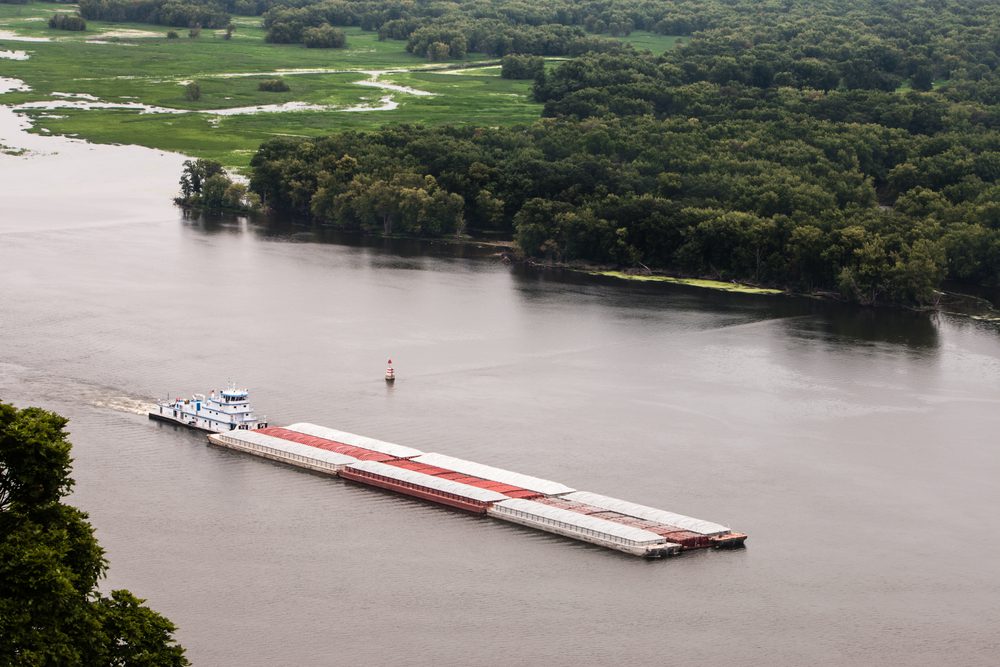Photo: Kira Volkov/Shutterstock
 By Karl Plume and Rod Nickel May 17 (Reuters) – The upper Mississippi River fully reopened to boat and barge traffic this week for the first time since November as shippers scrambled to move a backlog of overdue fertilizer barges to farmers racing to sow corn before the end of the month.
By Karl Plume and Rod Nickel May 17 (Reuters) – The upper Mississippi River fully reopened to boat and barge traffic this week for the first time since November as shippers scrambled to move a backlog of overdue fertilizer barges to farmers racing to sow corn before the end of the month.
Some fertilizer shipments had been parked on river banks near St. Louis and further downriver for more than two months as the worst Midwest flooding since 1993 shuttered locks and triggered shipping restrictions on the flood-swollen waterway.
The U.S. Coast Guard lifted its shipping ban in the Mississippi River’s St. Louis harbor on Wednesday for the first time since May 2. The last upriver locks, some that were shuttered by floods in mid-March just as they were due to open after routine winter closures, were reopened by the U.S. Army Corps of Engineers on Thursday.
The shipping window may be short-lived, however, as heavy rains expected across the Midwest over the next week could again raise water levels on the river, the main U.S. artery for grain and fertilizer shipments.
Shippers are facing tight deadlines to deliver the crop nutrients ahead of upcoming corn planting deadlines, after which fertilizer needs may be lessened as more farmers switch planting plans to soybeans.
The scramble is the latest challenge for the U.S. agricultural sector already stung by declining farm incomes and slumping commodities prices made worse by a U.S.-China trade war.
“If they can get the corn seed into the ground, then there will be a mad dash to get fertilizer onto it. That is certainly a 30-day window,” said Kreg Ruhl, crop nutrients manager at Growmark.
Shipping restrictions have blocked Growmark from supplying areas north of St. Louis, stranding enough fertilizer for some 450,000 acres on barges, “stuck in the logjam,” he said.
The river backlog, triggered by melting of unusually heavy snow and record-shattering rains, is among the worst the industry has experienced.
“It’s very rare for all locks to be closed at the same time on our portion of the river … each of those locks has its own trigger point when the water forces a closure,” said Allen Marshall, public affairs officer for the Army Corps’ Rock Island District.
STALLED PLANTING
Planting delays have so far tempered fertilizer needs in many areas, but the supplies will be needed as more corn is sown.
Just 30 percent of the U.S. corn crop was seeded as of last Sunday, well behind the five-year average of 66 percent planted by early May, according to the U.S. Department of Agriculture (USDA).
Fertilizer suppliers absorb some risk if they overshoot demand with shipments of urea, UAN and ammonia fertilizer that may miss the corn planting window and not be needed until fall, Ruhl said.
Corn sown too late can see smaller yields come autumn, and crop insurance benefits decline after regional deadlines lapse. Iowa’s final corn planting date is May 31 and the cutoff for most of Illinois is June 5, according to the USDA’s Risk Management Agency.
Although more rains are expected in the week ahead, a rapid planting rate in recent years suggests farmers only need a brief window to complete field work.
“Every day now counts, but through May there is a good-sized window to … get the fertilizer on the ground,” said Chuck Magro, chief executive of Nutrien Ltd, the biggest U.S. farm supply retailer, on a May 10 conference call.
Mark Behrman, CEO of nitrogen fertilizer supplier LSB Industries, said he is less optimistic than some about corn plantings, however.
Farmers in wet regions are unlikely to get all the fertilizer they need from other suppliers in time, even with barge restrictions being lifted, he said.
“It’s not easing fast enough,” he told Reuters. (Reporting by Karl Plume in Chicago and Rod Nickel in New York Editing by James Dalgleish)
(c) Copyright Thomson Reuters 2019.

 Join The Club
Join The Club











